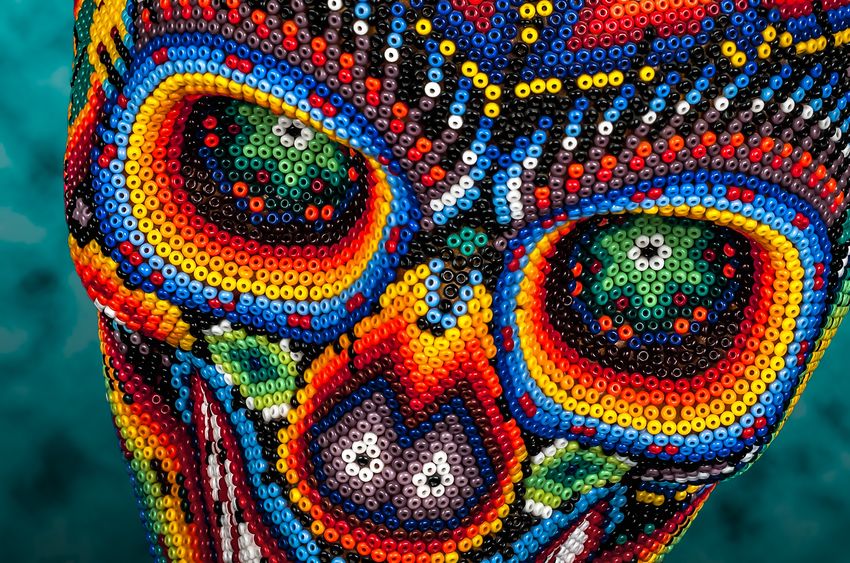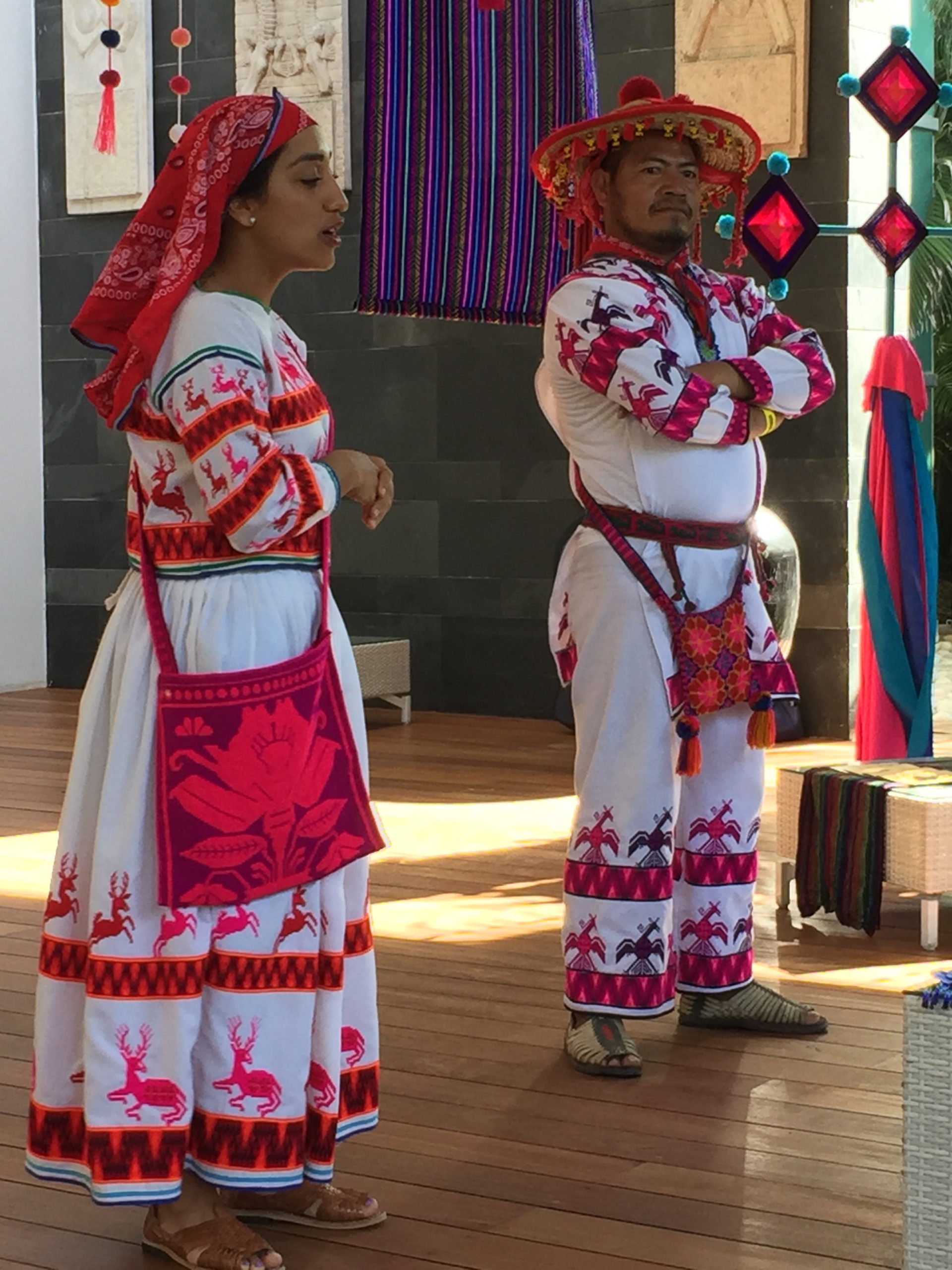
If you’ve traveled near the US/Mexico border, you’ve no doubt seen the beaded artwork in various shops and stalls. Sometimes you’ll even see someone painstakingly working on an art piece in the shop, tapping tiny, colorful beads into a beeswax-coated wooden carving of an animal, a mask, or perhaps an egg. We’ve bought our share of those, and have enjoyed giving them as gifts to friends. But if you think these pieces constitute the entire breadth of Mexican Folk Art, you are sorely mistaken.
Several years ago, while shopping in downtown Puerto Vallarta, we stumbled upon a shop called Peyote People. We have since made it a must-see shop whenever we are in town. The store is full of truly authentic Mexican folk art, and it’s all of a quality you won’t find in the typical stall on the Cuale River (not that you can’t find a good treasure there – you just have to wade through a lot more.)
 We were enthralled with the fabulous alebrijes pieces on display in the window. These are painted copal wood carvings out of the Oaxaca region – fantastical depictions of animals in various poses. We picked up several very well-done works. Characteristic of alebrijes is the presence of a movable part – the tail, ears, legs, etc. On high-quality pieces this piece is fitted very neatly, and the insertion points are finished well. The carving is polished smooth, and the paint colors are slightly glossy, with many colors on one piece. The detail painting is fine, done with a tiny brush to fill in hair and eyes. In addition, there’s often a brush element made from dried grasses for a mane or a tail.
We were enthralled with the fabulous alebrijes pieces on display in the window. These are painted copal wood carvings out of the Oaxaca region – fantastical depictions of animals in various poses. We picked up several very well-done works. Characteristic of alebrijes is the presence of a movable part – the tail, ears, legs, etc. On high-quality pieces this piece is fitted very neatly, and the insertion points are finished well. The carving is polished smooth, and the paint colors are slightly glossy, with many colors on one piece. The detail painting is fine, done with a tiny brush to fill in hair and eyes. In addition, there’s often a brush element made from dried grasses for a mane or a tail.
Out of the Nayarit region come the more familiar bead-coated carvings, but again, the depictions are not just the usual skulls or Day-of-the-Dead masks. At Peyote People, we found artistic expressions of eagles and coyotes, with beading so intricate it must have taken months or years to finish a piece. The beaded eggs are fun and still good gifts, but these pieces are true works of art, meant to be displayed prominently and admired for years.

And then we saw the yarn paintings. If you go for nothing else, just stop in to admire the work on these, because it is astonishing. Like the beadwork, the paintings are created on a beeswax-covered board, but instead of beads, the artist uses colored yarns, spaced tightly in a spiral pattern to create fantastic creatures inspired by visions from peyote.
Peyote is central to the culture of the Huichol (they refer to themselves as Wixáritari or Wixárikas) people. The Wixárikas are an indigenous group from Mexico whose culture has remained unscathed by outside influence for centuries. They have preserved their language, religion, customs and ancestral traditions throughout time.
Today, the Wixárikas occupy the western Sierra Madre primarily in the state of Nayarit, but also Durango, Zacatecas and Jalisco. The population is estimated at 45,000. Though they survive in small villages off subsistence farming, you will often see them in their bright traditional costumes in many large cities, creating and selling their artwork.

Each year, there is a pilgrimage to a sacred region called Wirikuta, a now-protected area near Real de Catorce – a 400 km journey, usually taken on foot! There they gather what they consider the most desirable crop of the small, round, cactus known for its hallucinogenic properties. Under its influence, they experience dreams or visions of communion with the deities, which they then represent in their art. This piece above, by the famous artist Jose Benito Sanchez, depicts just such a scene.
There are many symbols found in Huichol art. This chart explains some of them.

In the painting further up the page, you can see the deer, the serpent, the maize, the shaman holding a muwieri, and the squiggly lines that represent communication with the gods. According to mythology, during the first deer hunt in Wirikuta, the tracks of the prey become shining plants of peyote, bringing prosperity, health, and food to their people. Today, venison is considered the “meat of the gods,” the most important gift to transcend from the profane world to the sacred.
We have other pieces that focus on other symbols. And very often you will see the small, round peyote button represented somewhere in the piece.
Another reason we enjoy visiting the Peyote People shop, is that they provide expert guidance on selecting the best pieces, by established artists. Our pieces are by Jose Benito Sanchez, whose work is truly outstanding. Just look at the detail here:

This is just one of the reasons we love our time in Puerto Vallarta. Finding treasures like these has been a highlight of our lives. We think you would enjoy it too.
If you’d be interested in securing a beautiful spot to stay in the Puerto Vallarta or Riviera Maya areas, check out my other posts on Vidanta. We can often secure a week for you in one of our large 2 bedroom Luxxe units, or in a different size space that meets your needs.



